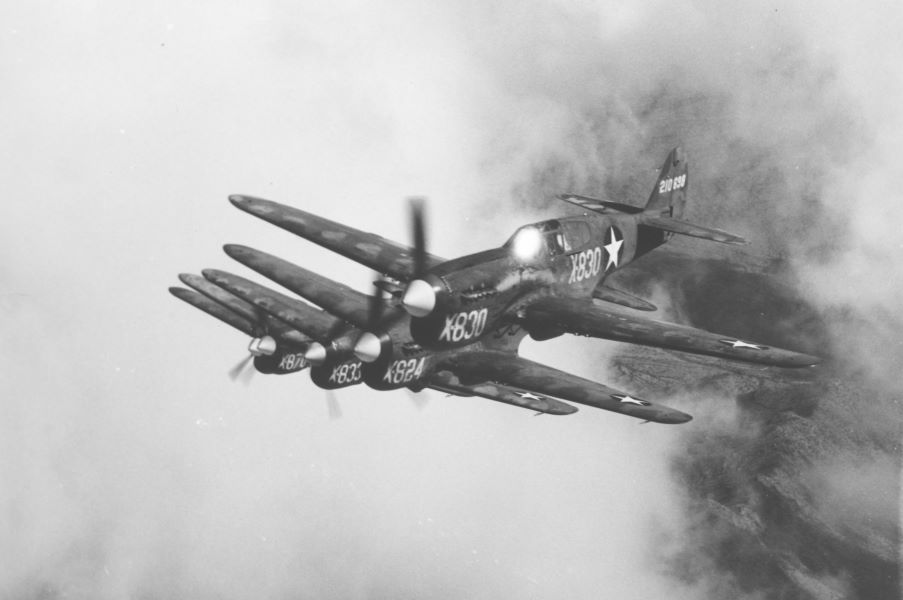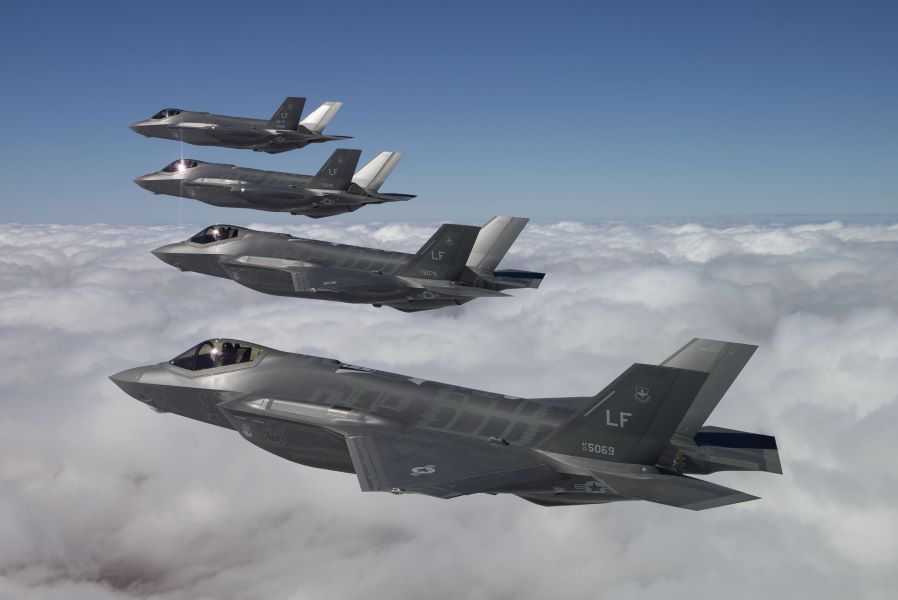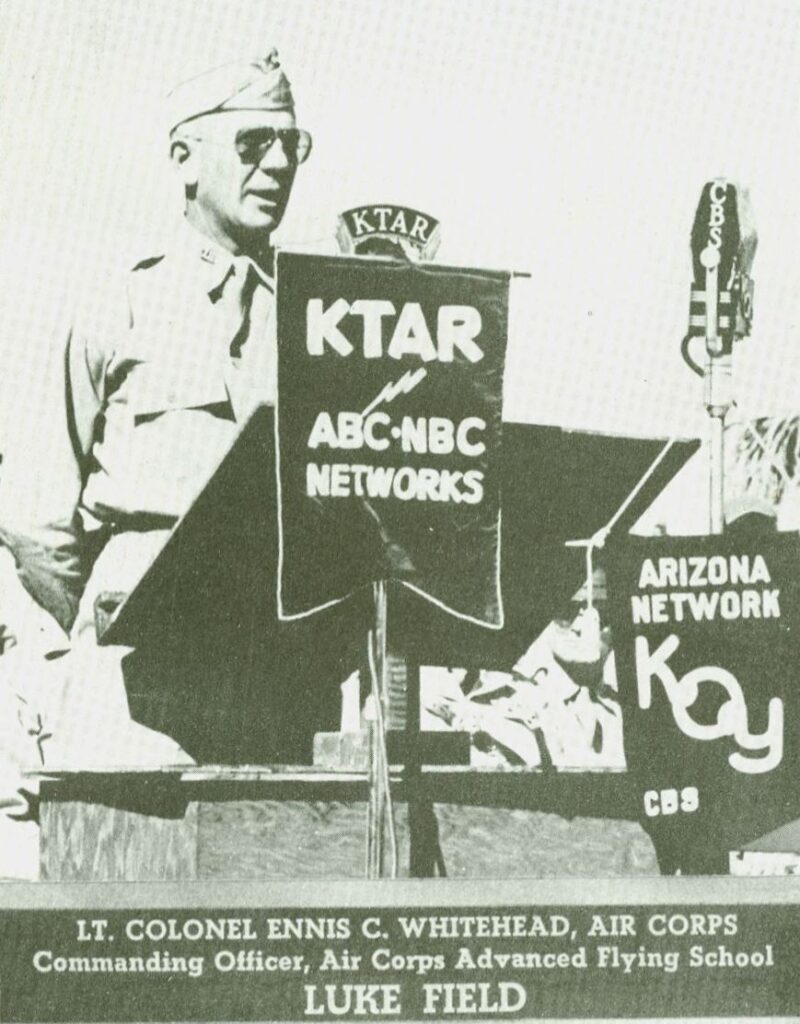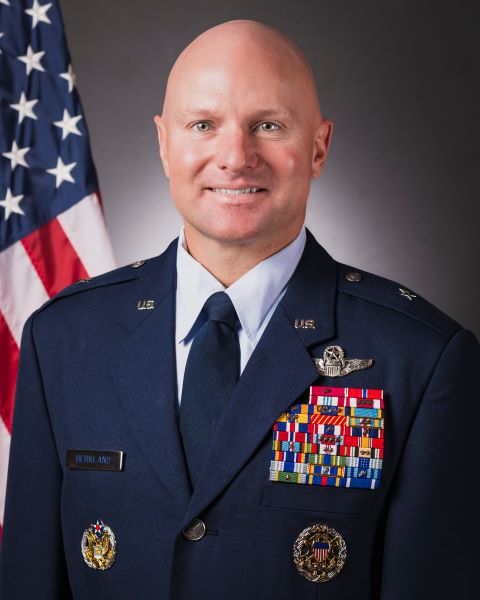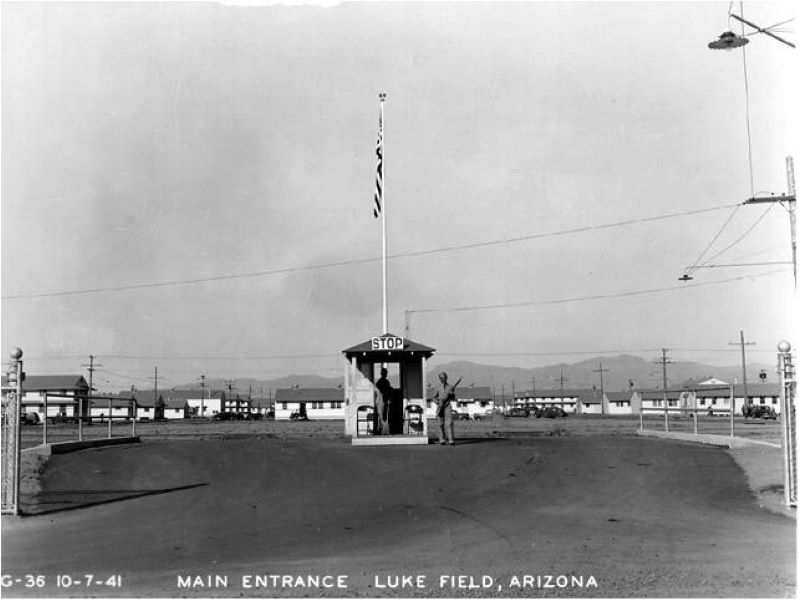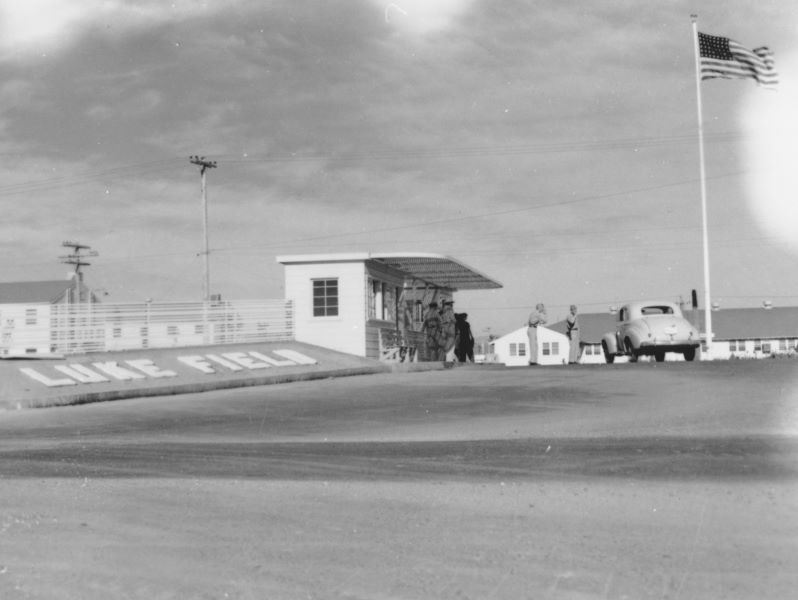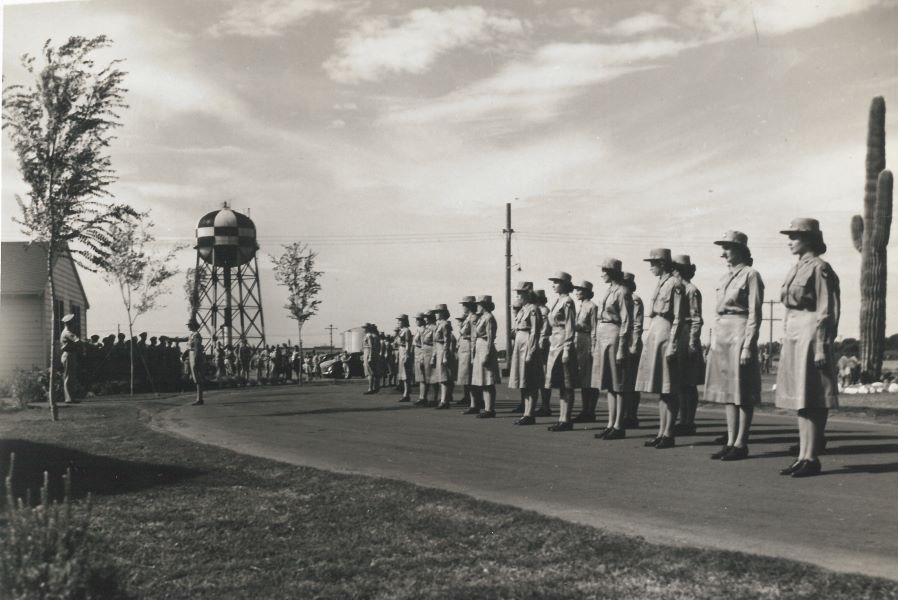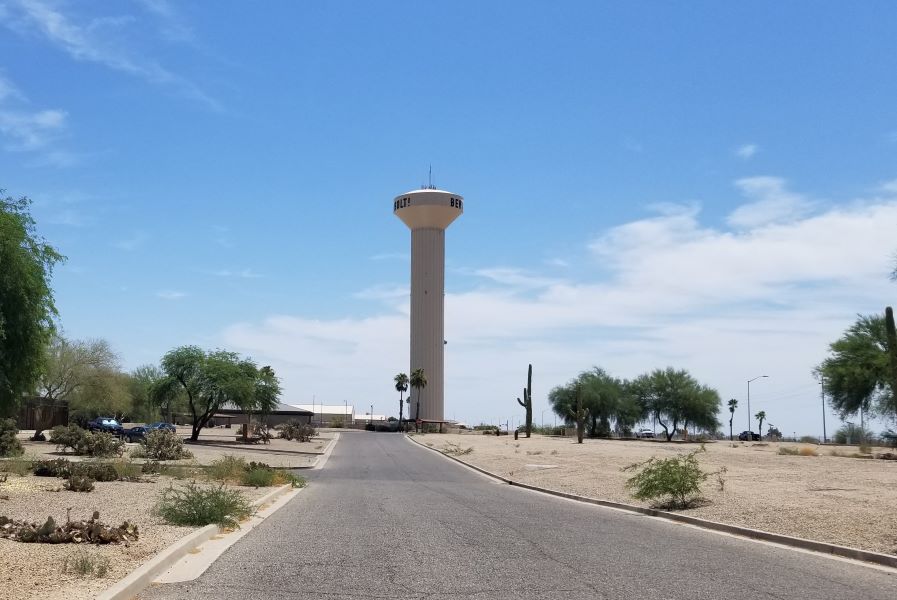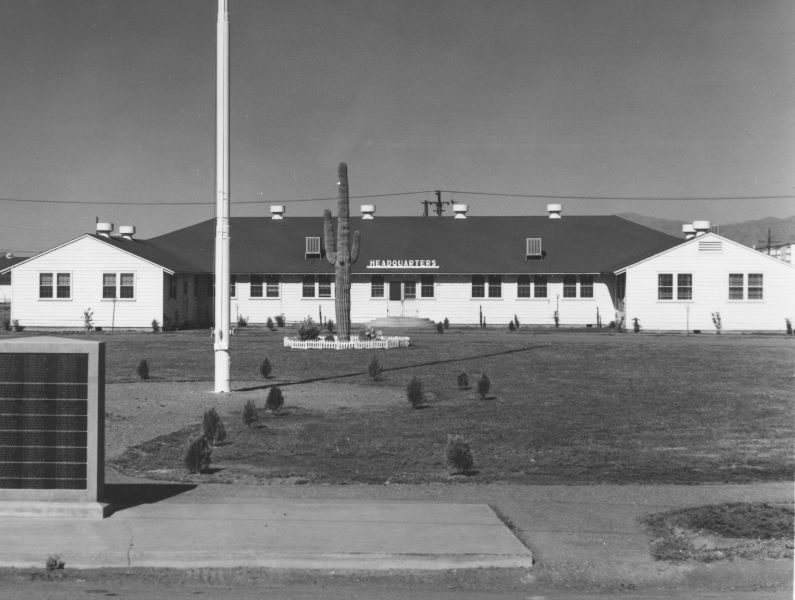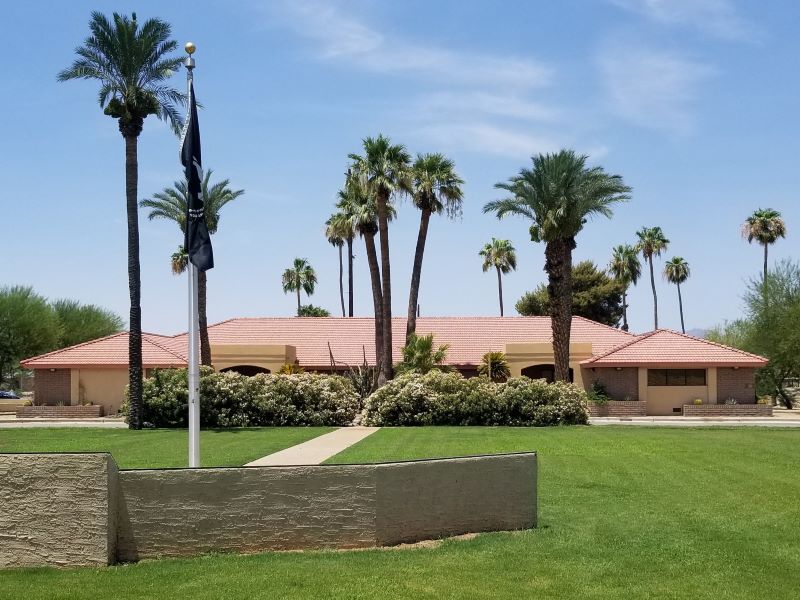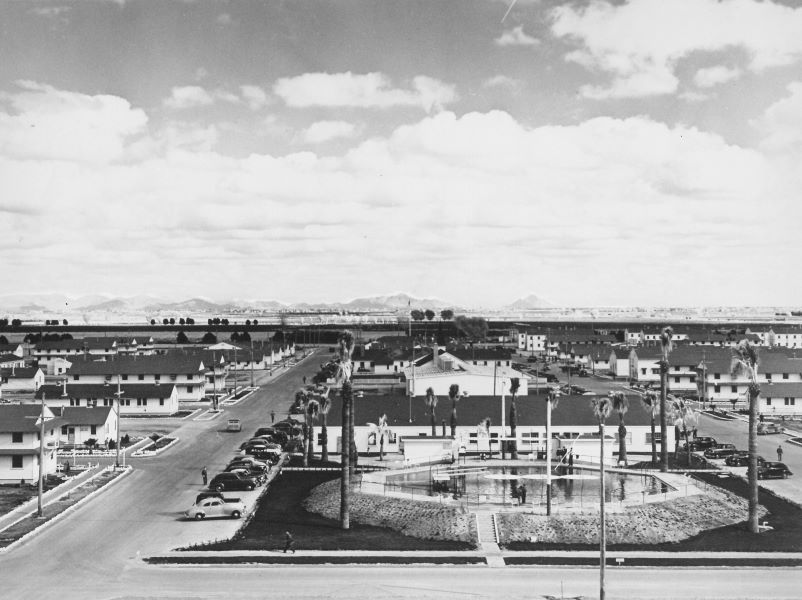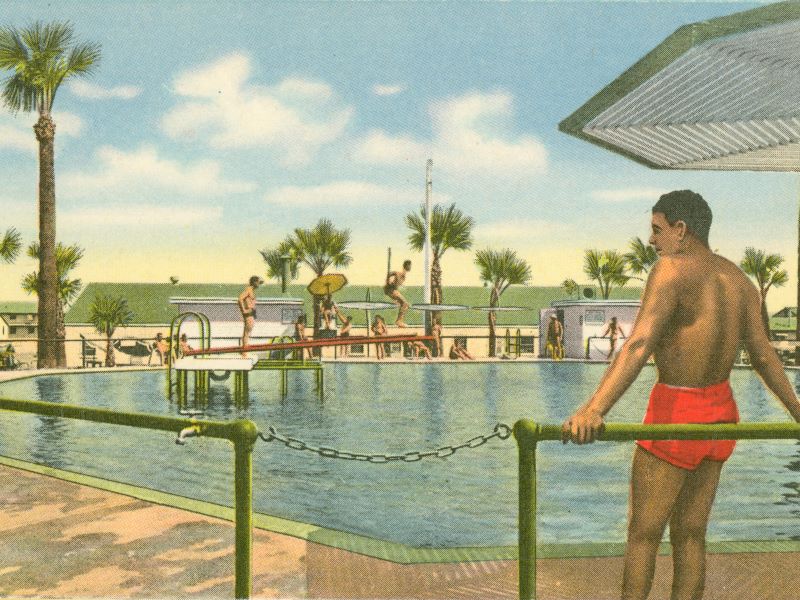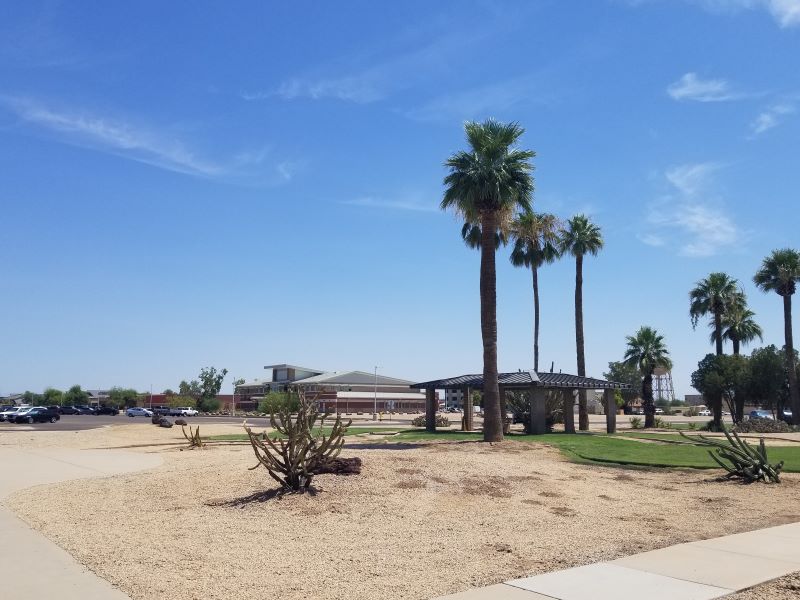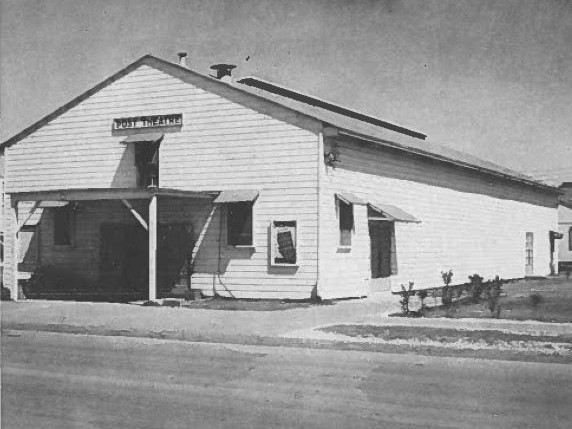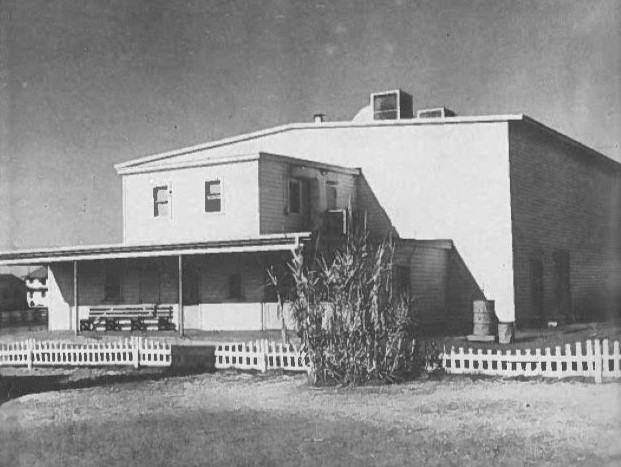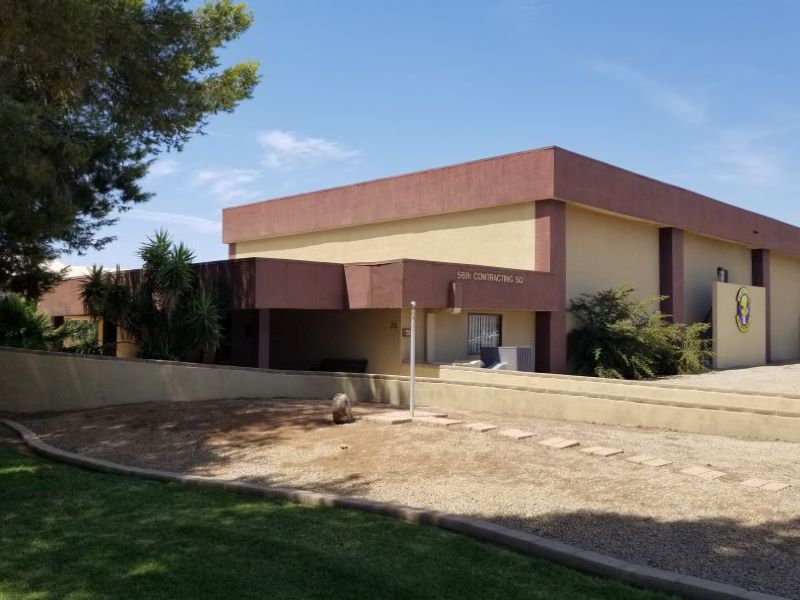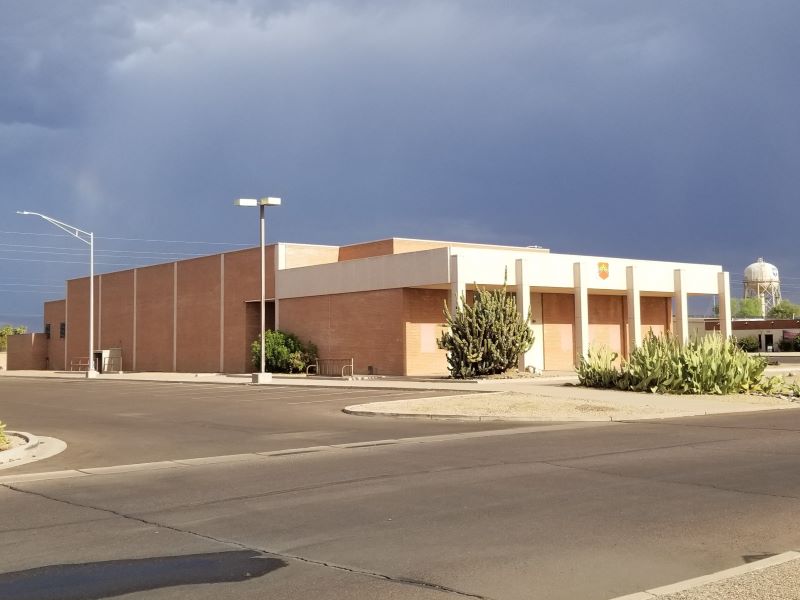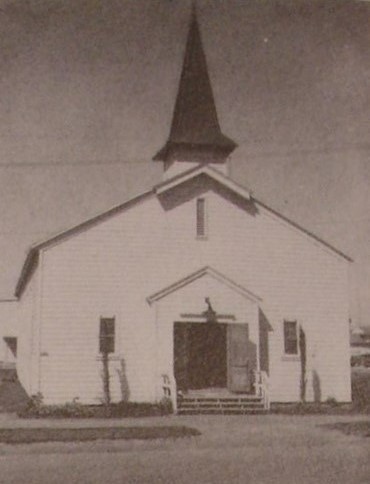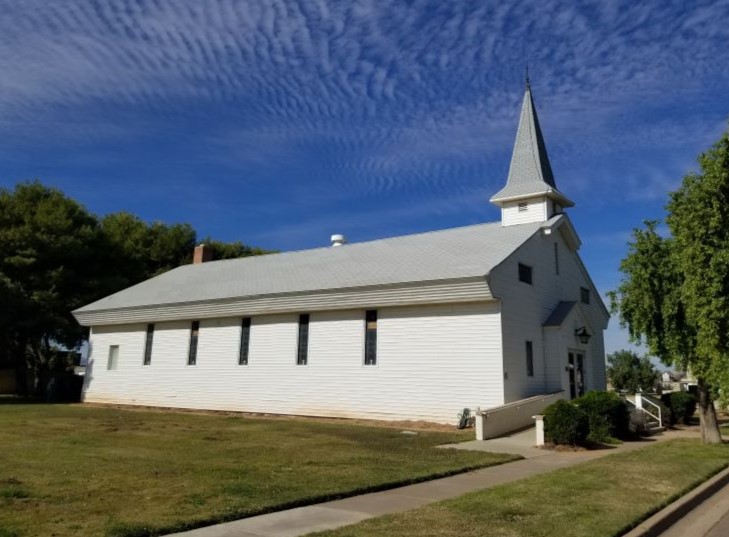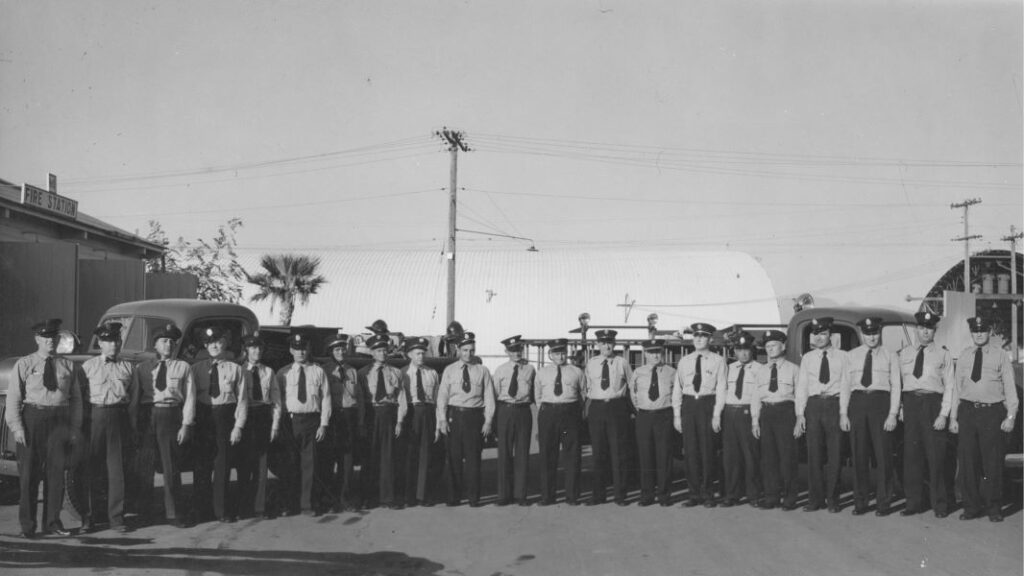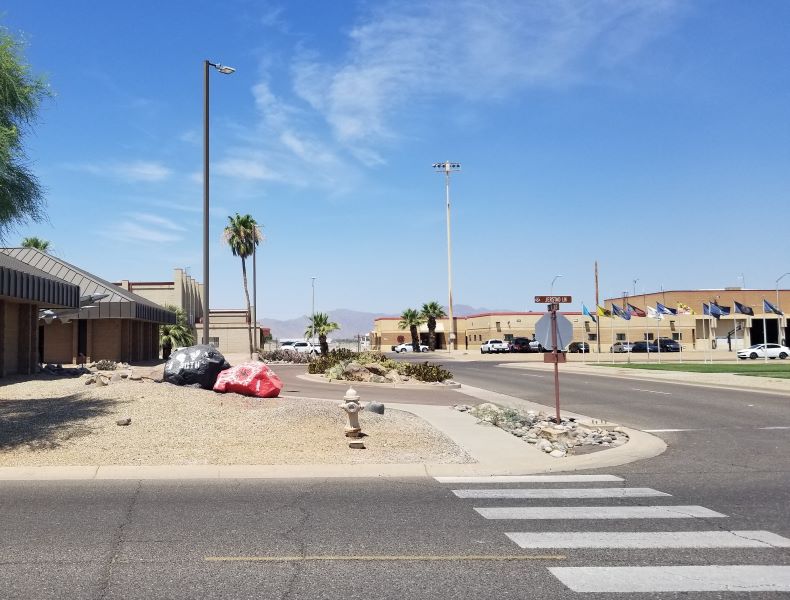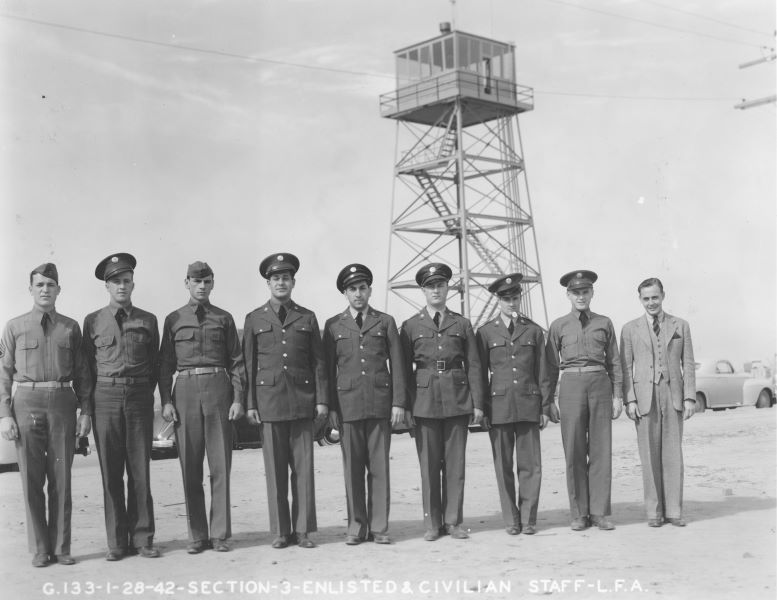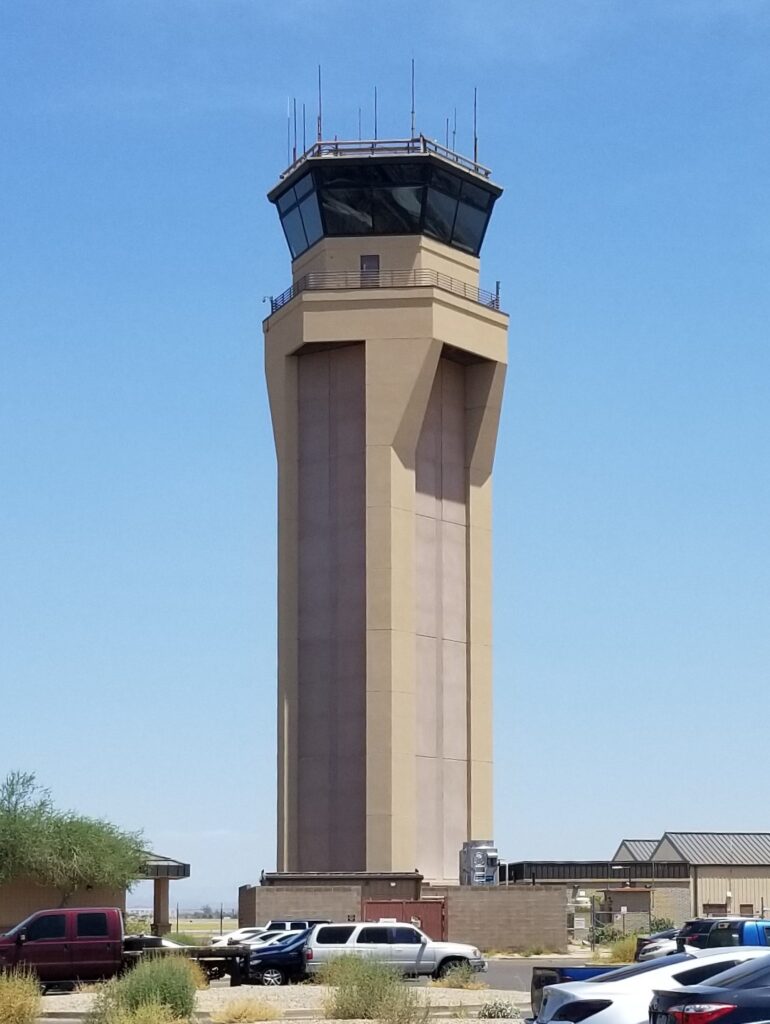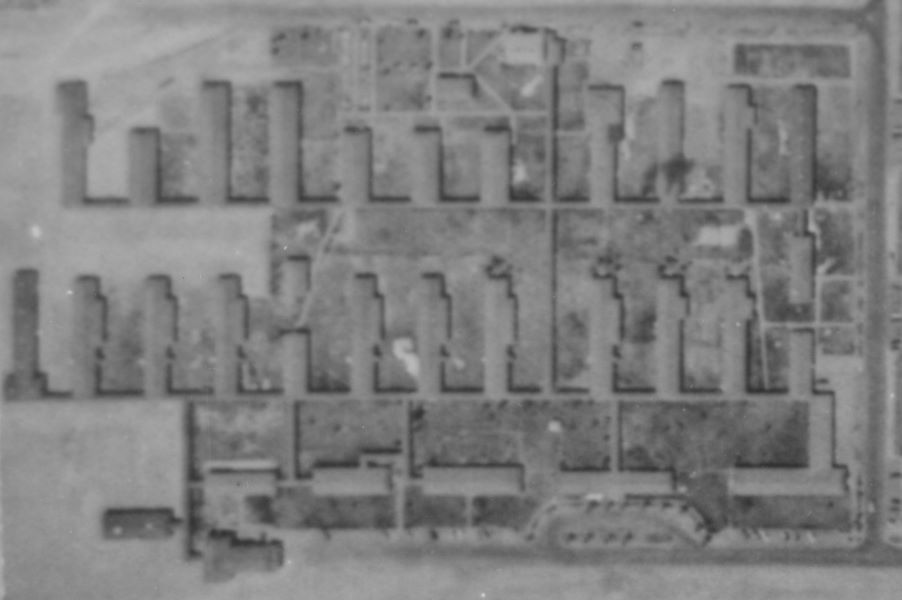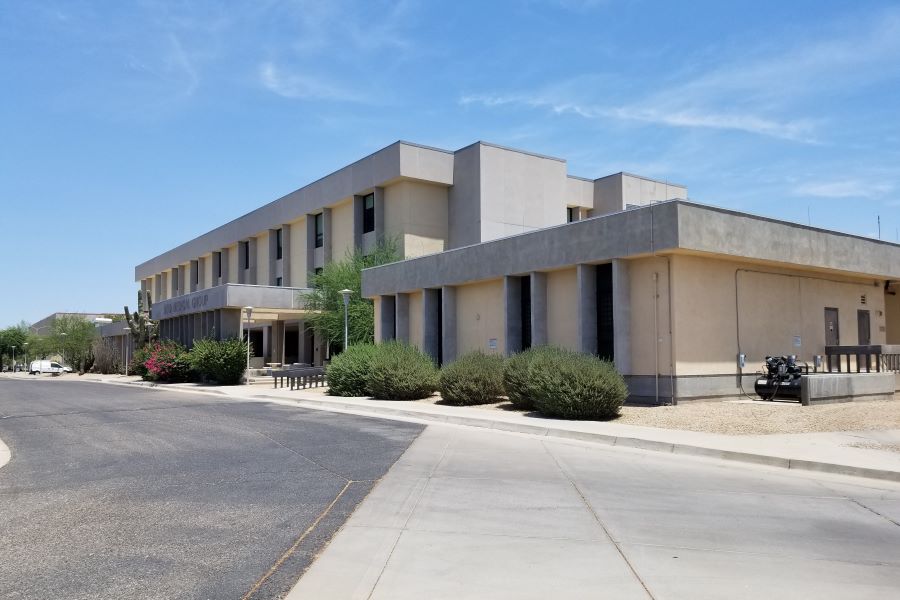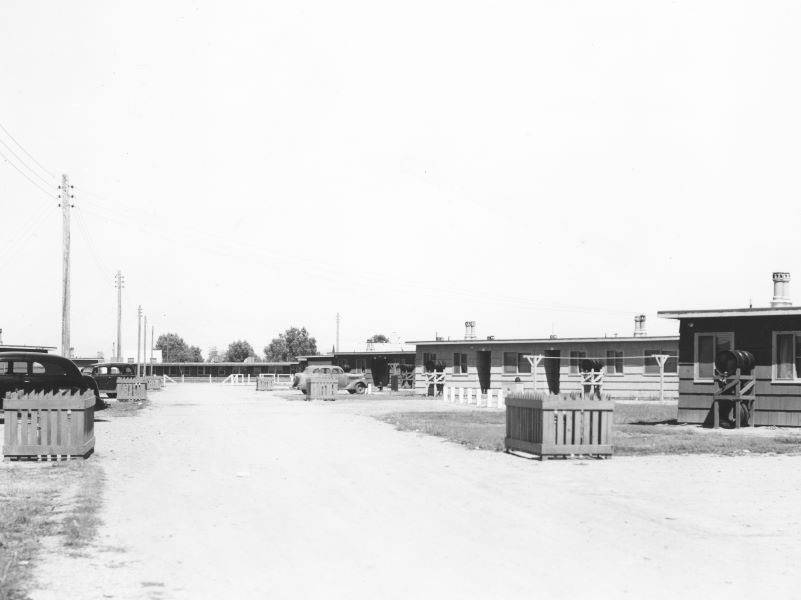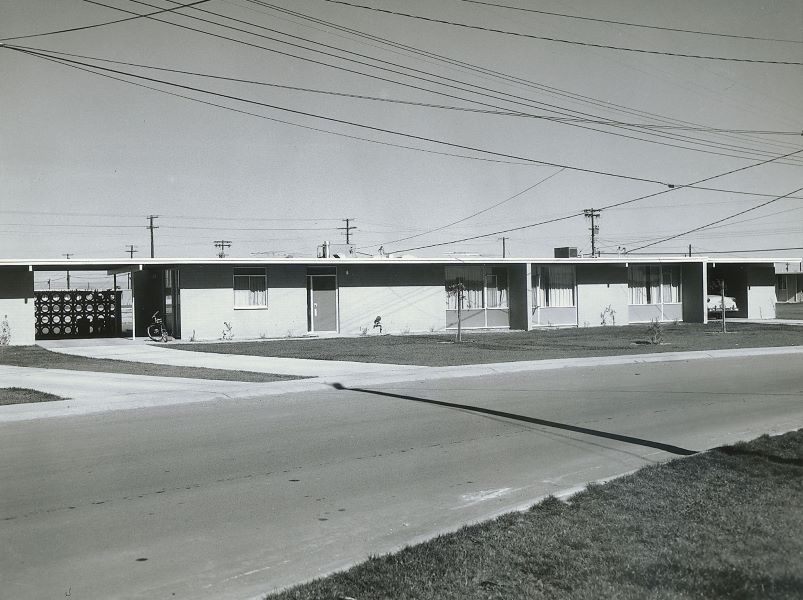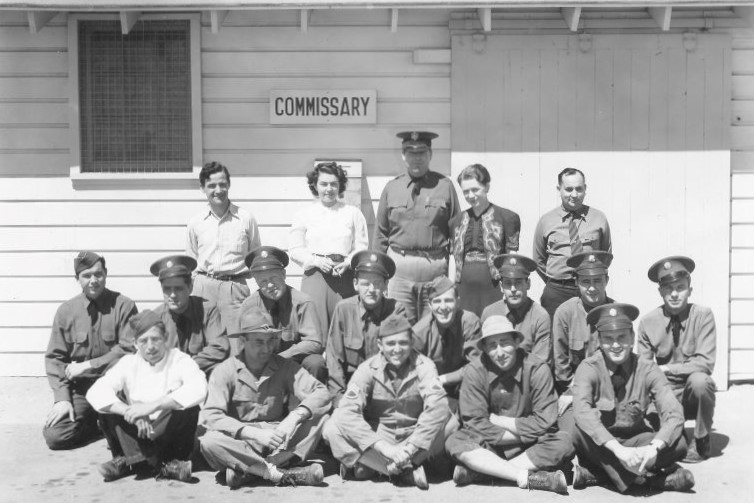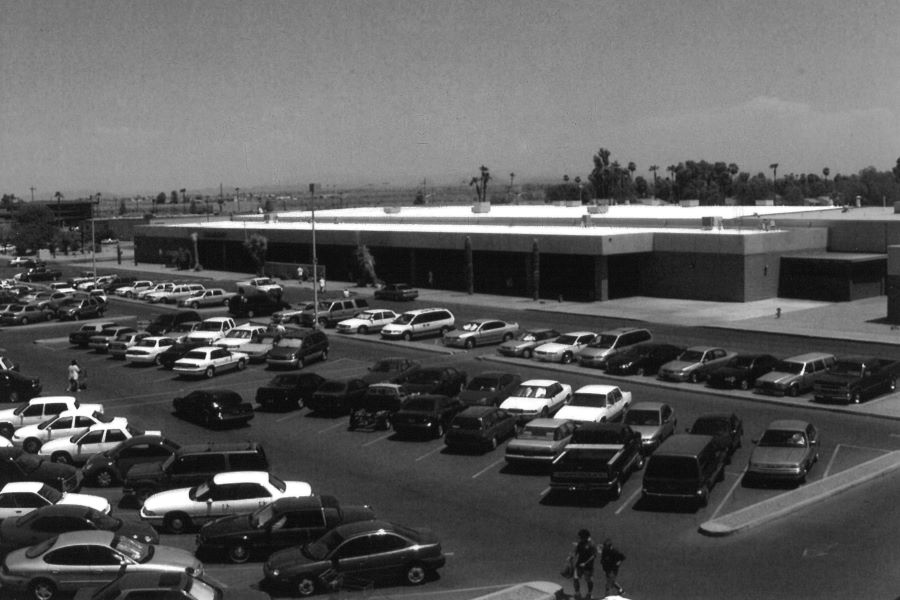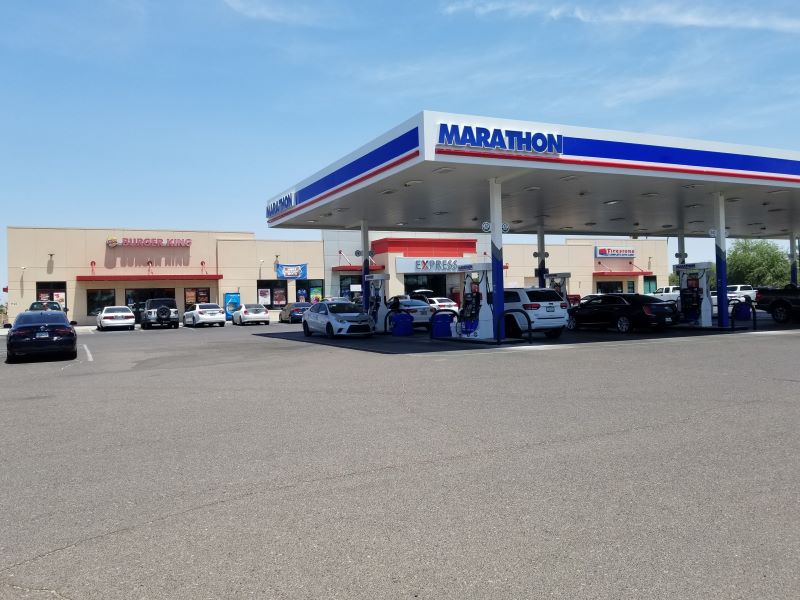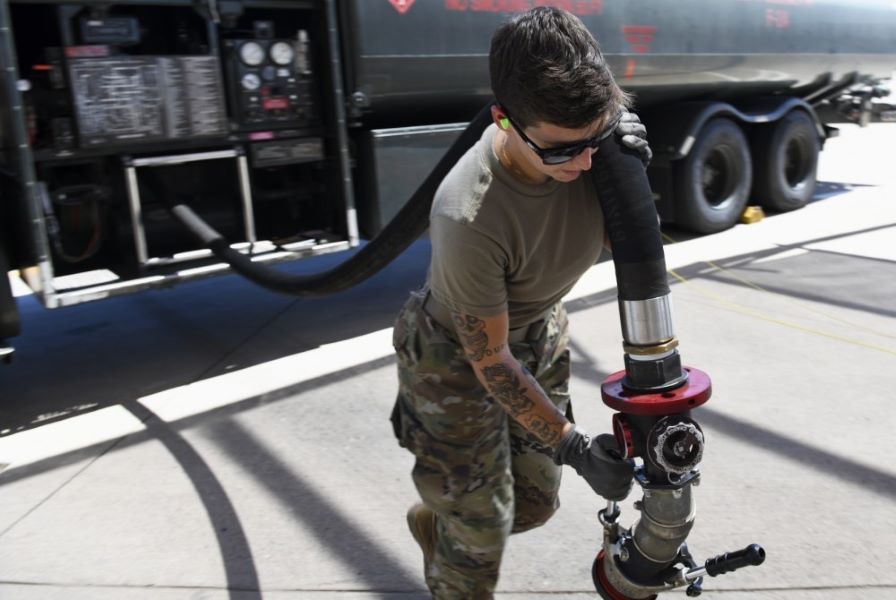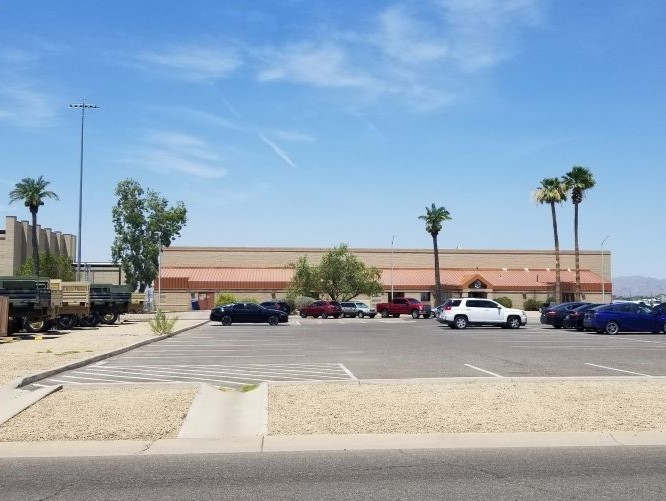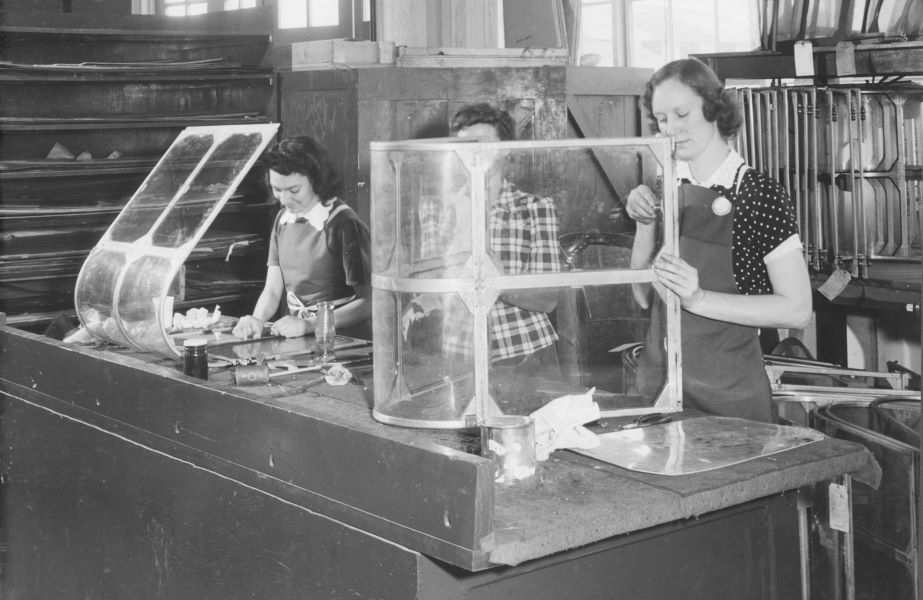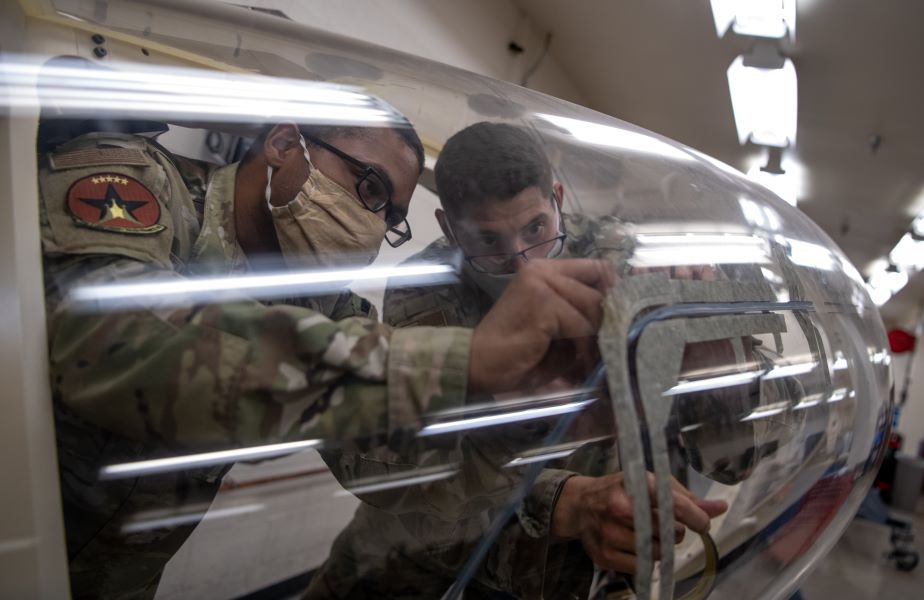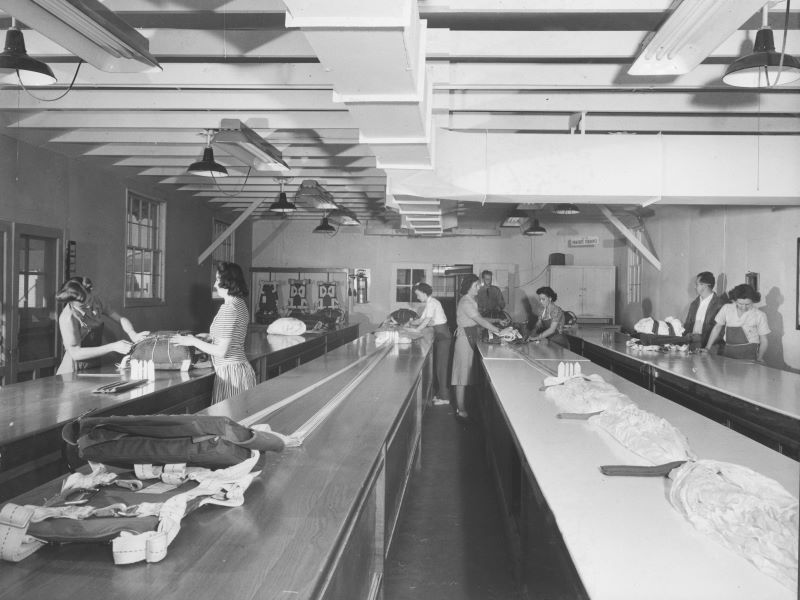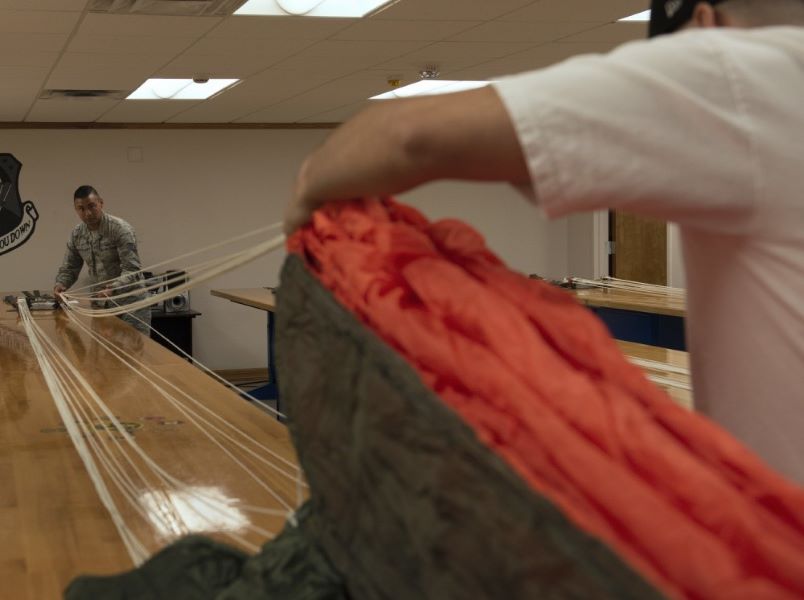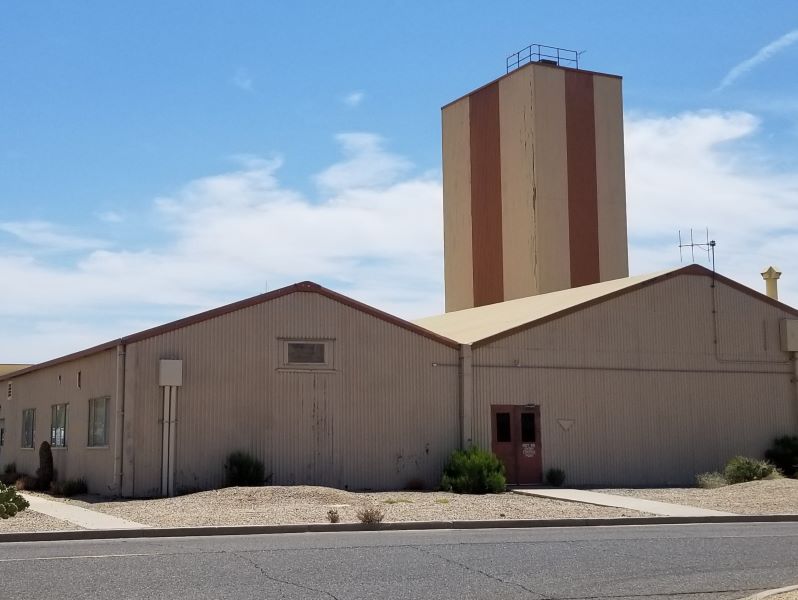To honor the men and women who flew and trained at Luke Field, Arizona, during World War II.
Then & Now
While Luke Field was inactivated in 1946, it was reactivated in 1951, five short years later. Renamed Luke Air Force Base, its mission was to train pilots to become fighter pilots. Over 50 years and 12 types of aircraft later, the base is still carrying out that mission. A few of those original temporary buildings are still there and are in use today. The following photos compare some of the places that existed in WWII and what they look like closer to today.
1951 Map of the West Valley
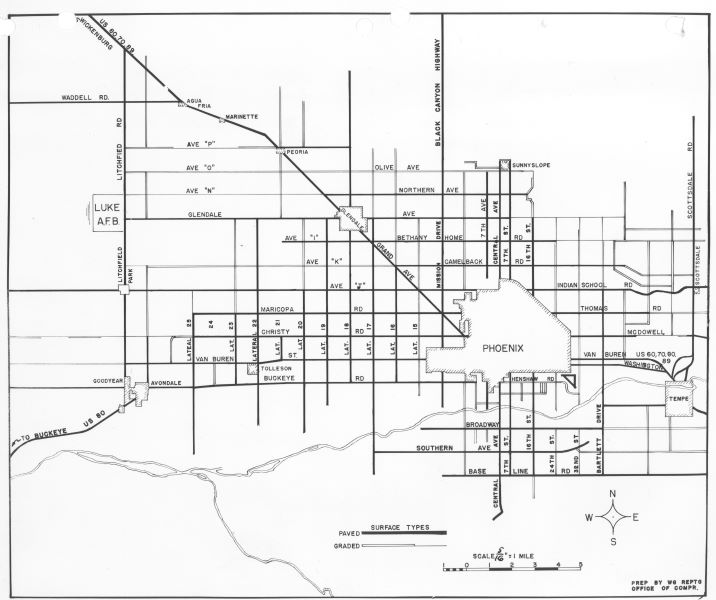
When Luke Field was created, many people thought it was out on the middle of nowhere. They were not far off. At that time, the land around Luke Field was a mix of desert and farmland. The closest incorporated town, Tolleson, was 9 miles away to the southeast. Tolleson was incorporated in 1929, as was Buckeye, which was 17 miles to the southwest from Luke Field. The other close town was Glendale, due east, 11 miles away. The only other towns or cities in the West Valley were Phoenix (incorporated 1881) and Wickenburg (incorporated 1909). Phoenix was 19 miles away to the east southeast, and Wickenburg, was 36 miles away to the northwest. The rest of the communities that were around Luke Field were small farming communities.
This 1951 map shows that not much changed in the five years that Luke Field was inactivated. It should be noted that in 1951 the city of Phoenix did not even reach the current 43rd Avenue. In 1946, two towns incorporated, both 7 miles away. Avondale and Goodyear are both due south of Luke Field. In 1951, El Mirage incorporated, 6 miles to the north northeast. It currently contains the village on the map called Agua Fria. Surprisingly, the closest community to Luke Air Force Base was Litchfield Park, just 3 miles due south, but it did not incorporate until 1987. Other communities on the 1951 map in the West Valley are Peoria and Marinette. Peoria continued to grow and incorporated in 1954. Marinette became a ghost town and that area is now part of the unincorporated Sun City, which opened for sales in 1960. (U.S. Air Force photo)
Mission
While the initial mission for Luke Field was to train aviation cadets to fly, by early 1942, that mission changed to include training/transitioning trained military pilots to fly fighter aircraft. Since that time, Luke Field, and later Luke Air Force Base, excelled at that latter task. On the left, the P-40 Warhawk was the first fighter Luke Field used to transition pilots to fighter aircraft. (Photo by Luke Field Photographic Section) In 1945, Luke Field added both P-38 Lightning and P-51 Mustang transition training, which lasted through the end of the war with Japan. Since then, there have been 12 more fighters at Luke Air Force Base that the base has used to transition pilots into fighter aircraft. On the right is the newest aircraft at Luke, the F-35A Lightning II. in 2014, Luke Air Force Base received its first F-35As . The photo was taken on November 15, 2015, during the 62nd Fighter Squadron’s first 4-ship training mission conducted in the F-35A. (U.S. Air Force photo)
Leadership
In early 1941, Lt. Col Ennis C. Whitehead, pictured on the left, was tasked with starting a flying training school in the Phoenix Valley. He chose the site for Luke Field, oversaw its initial construction, started the flight training effort, and commanded Luke Field until July 1942. In other words, Ennis C. Whitehead was the father of Luke Field. Within three years of his departure, Whitehead would be a Lieutenant General. (Photo by Luke Field Photographic Section)
Leadership is still important today. The current commander is Brigadier General David J Berkland pictured on the right. (U.S. Air Force photo)
Main Gate
Most bases have multiple gates into the facility. Luke Field was no different. That said, most bases have a Main Gate where the vast majority of traffic enters the base. Luke Field’s Main gate from 1941 until the mid-2000s, was on the west side of Litchfield Road north of Glendale Ave. Initially, it was just a guard shack in the middle of the entrance, pictured on the left. (Photo by Luke Field Photographic Section) Luke Field soon made improvements resulting in a larger guard shack to the south side of the entrance, pictured on the right. (Photo by Luke Field Photographic Section)
In 2007, the base completed construction of the Major Troy L. Gilbert Memorial Bridge, pictured on left, over the site of the original Main gate. The day construction started on the bridge, November 27, 2006, was the same day Major Gilbert was killed in action in Iraq. (Photo by lukefieldaz.com) Two years earlier, they completed construction on the Visitors Center and South Gate entrance. The South Gate was designed to handle large tractor-trailers and increased security requirements. Located on the west side of Litchfield Road, the South Gate is halfway between Glendale Ave. and Bethany Home Road. In 2006, the South Gate (pictured on right) became the Main Gate for Luke Air Force Base. (Photo by lukefieldaz.com)
Water Tower
Water Towers are an iconic feature on many Air Force bases. While they have a civil engineering use to provide water at pressure to the base, they are often a symbol of that base. Taken sometime during WWII, the photo on the left shows a formation of female Airmen in front of the Headquarters building with the Water Tower in the background. (Photo by Luke Field Photographic Section) If one looks closely, the photographer caught the leader of the formation and the senior officer in mid-salute. On the right is that same location today. Both the building and the Water Tower are still in use. Currently, the writing on the WWII Water Tower says WELCOME TO FIGHTER COUNTRY. (Photo by lukefieldaz.com) After the base expanded it facilities to the southwest, its need for another water tower grew. In 1988, the newest Water Tower completed construction south of the West Ramp, see photo below. Currently, the new Water Tower carries the motto of the 56th Fighter Wing, the host wing on Luke Air Force Base. The motto is BEWARE THE THUNDERBOLT, which was the motto the 56th Fighter Group used during WWII. (Photo by lukefieldaz.com)
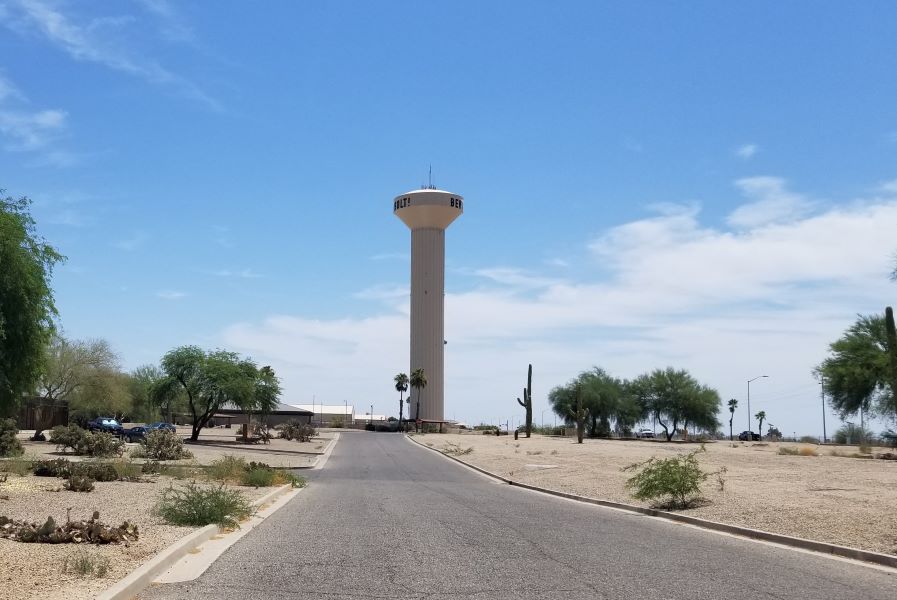
Headquarters Building
Just inside the old Main Gate, in the photo on the left, was the WWII Headquarters building, S-11, as seen in 1951. Other than a new roof and a coat of paint, the building changed little from what it looked like during WWII. (U.S. Air Force photo) Completed in 1942, the building got a facelift around 1990, current picture on the right. It remained the Headquarters building until June 13, 2001. On that date, the 56th Fighter Wing moved its Headquarters function to building 452, which was completed early in 1991. Building 452 originally housed the 405th Tactical Training Wing Headquarters for the F-15 wing. On October 1, 1991, due to an Air Force-wide reorganization, the 405th inactivated and the 58th Operations Group activated and its Headquarters function worked in the building. On April 1, 1994, the 56th Operations Group replaced the 58th. In the photo below, the new Headquarters building is in the same location as the WWII Fire Station, near the flightline. (Photo by lukefieldaz.com) As for S-11, it currently houses the 56th Mission Support Group Headquarters function.
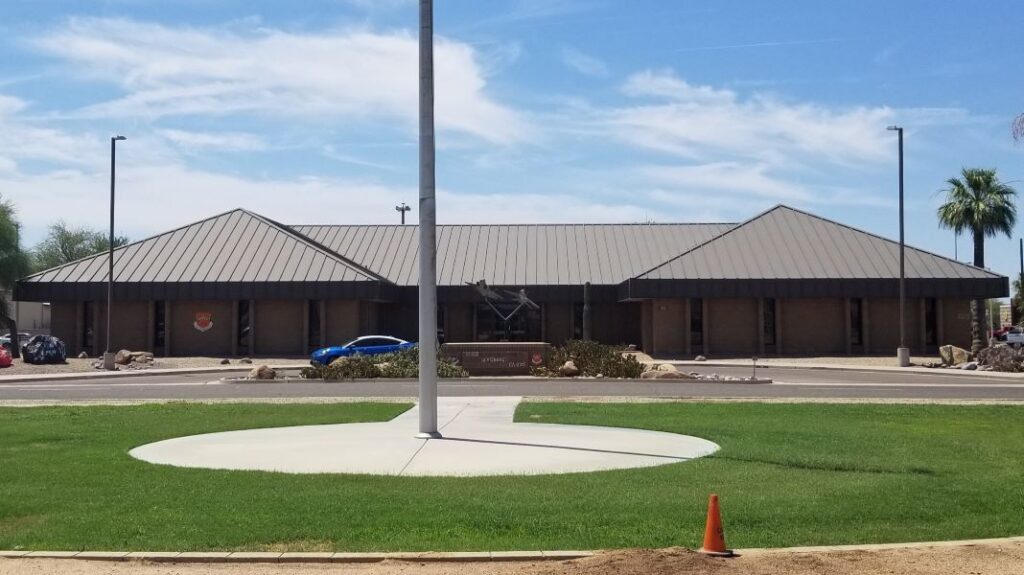
The Mall
By 1943, the construction on what is now referred to as the Mall (or Air Park) was completed. The Mall was the area behind the Main Gate and Headquarters building, between two one-way streets, F and G streets (now Eagle and Falcon Streets), and went west almost to the flightline. At the time, the Mall contained the Pool, Post Exchange, Theater No. 2, the Chapel, and the communications building, along with several other functions. The photo on the left is looking east from the North Control Tower, with the pool in the foreground. (Photo by Luke Field Photographic Section) Today, the photo on the right shows the Mall from a similar location. Currently, the Mall contains the Air Park, the WWII Chapel and the 56th Contracting Squadron in the WWII Theater No. 2. (Photo by lukefieldaz.com)
Swimming Pool
For most people, the desert and swimming pools seem to go together. There is no better way to cool off in the Valley of the Sun than by getting in a pool. The pool was especially important during WWII, before heating, ventilation, and air conditioning, or HVAC, systems were in common use. Pictured on the left is the Luke Field Pool during WWII. The colorized post card was originally a photograph taken by the Luke Field Photographic Section. On the right is a photo from approximately the same location showing how that location looks today. (Photo by lukefieldaz.com) Today, the main pool, the Silver Wings Pool, pictured below, is located on the west end of where the WWII Family Housing used to be.
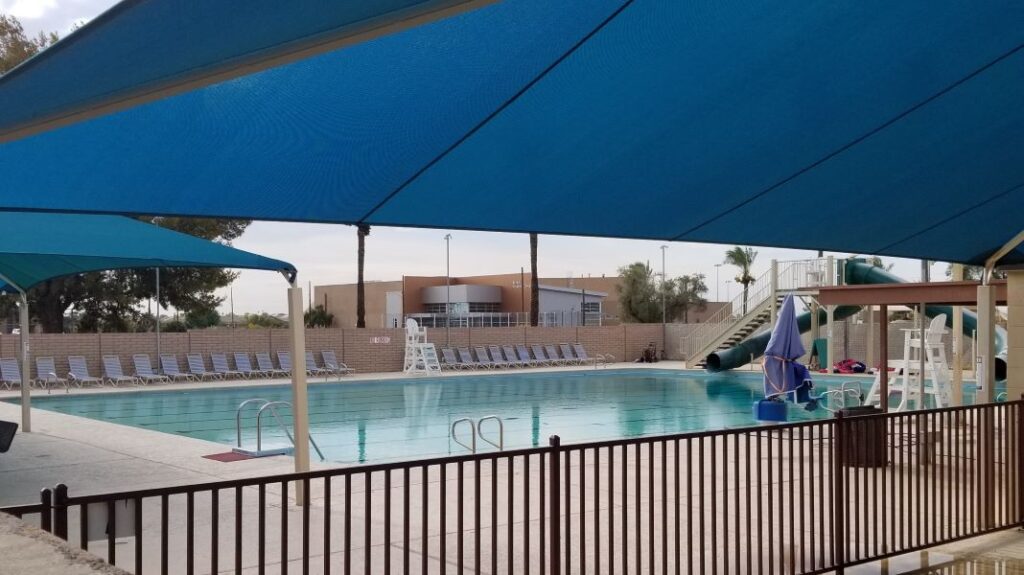
Theater
For young men, dozens of miles from the nearest city and little time off, entertainment was very important. In the 1940s, radio and movies provided a lot of that entertainment. Theater No. 1 was probably built in 1941, pictured on the left. (Photo by Luke Field Photographic Section) In 1942, Del Webb completed Theater No. 2, just west of the Chapel, on what is now the Mall, pictured on the right. (Photo by Luke Field Photographic Section) While it is unknown when the Theater No. 1 closed for good, Theater No. 2 continued in use as a theater until at least 1975.
At some unknown date, Theater No. 2 was converted internally into two stories and offices. In 1994, the 56th Contracting Squadron moved in. That building is pictured on the left. (Photo by lukefieldaz.com) In 1975, the much larger Theater was built on the east side of Litchfield Road near the Commissary and Base Exchange. In the 2000s, the new Theater ceased normal theater operations. Since then, it is occasionally used for large gatherings and stage productions, pictured on the right. (Photo by lukefieldaz.com) Both the Theater No. 2 and the new Theater buildings are still in use today.
Chapel
Built in 1941, even before the Headquarters building, the Chapel was an important part of the Post’s community. Besides services during training, services after a death, and marriages after graduation, the Chapel was used at times as a studio for Technical Sergeant Gene Autry’s weekly radio show. Situated between F and G streets (now Eagle and Falcon Streets), the Chapel is now considered on the Mall. The photo on the left was taken in 1943. (Photo by Luke Field Photographic Section) The photo on the right is current photo. The Chapel is still in use today. (Photo by lukefieldaz.com) In 1969, Luke Air Force Base built a second, larger Chapel, on the east end of what was the WWII family housing area, pictured below. (Photo by lukefieldaz.com)
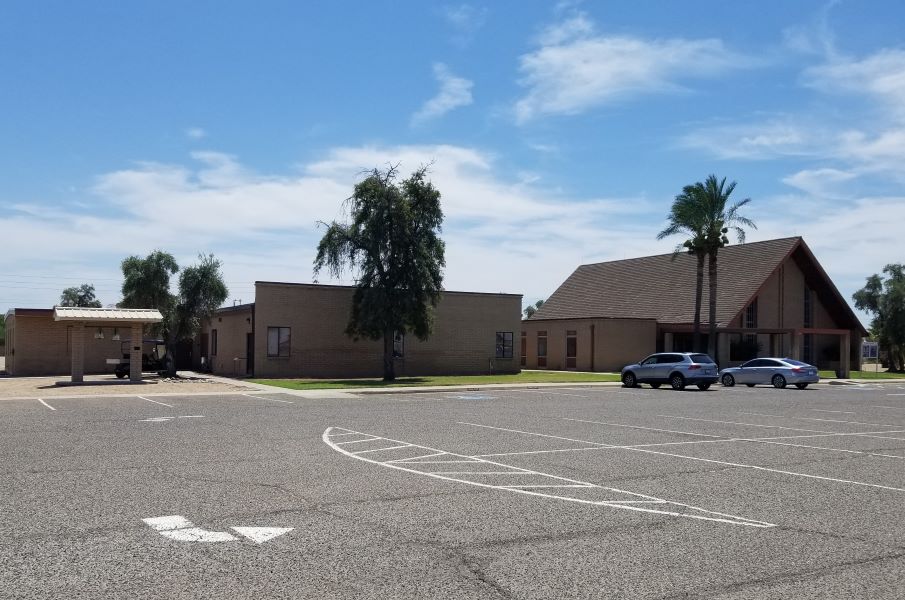
Fire Station
In the photo on the left, are the WWII Firemen in front of the Luke Field Fire Station (building on the left) near the flightline. The two large Quonset structures behind them were the two main aircraft maintenance hangars, not controlled by the 87th Sub Depot. (Photo by Luke Field Photographic Section) In the photo on the right, the old Fire Station’s location is now the 56th Fighter Wing’s Headquarters building (on the left side of the photo). Luke Air Force Base replaced the hangars in the mid-1980s. In 1987, they built the new Fire Station (on the right of the photo) and in 1988, they built another hangar (beyond the Headquarters building). (Photo by lukefieldaz.com) Below is a closer look at today’s Fire Station. (Photo by lukefieldaz.com)
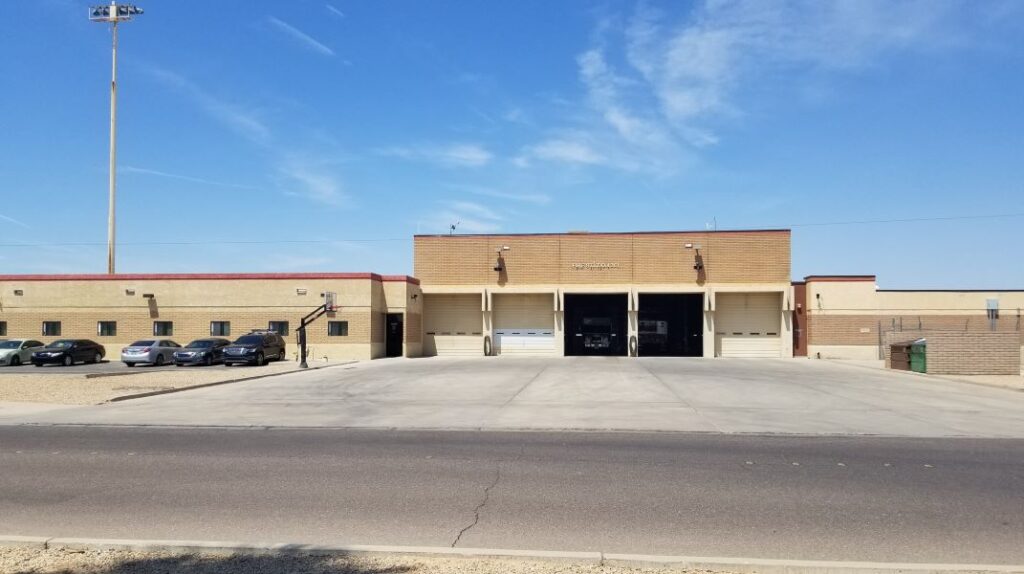
Control Tower
The people in the Control Tower handle many tasks in an effort to keep Airmen safe. Today, the Control Tower controls all of the aircraft on the base and in the air within a few miles of the base. That control begins with engine start, continues through taxi, takeoff, departure, returning back to the area and pattern, landing, and taxi, ending with engine shutdown. Pictured on the left and dated January 28, 1942, are enlisted men and civilian staff standing in front of the one of the two WWII Control Towers located on the east edge of the North Ramp. (Photo by Luke Field Photographic Section) On the right is the fgourth and current Control Tower located on the west end of the West Ramp at Luke AFB. Built in 2001, the new tower was taller than any of the previous structures and controlled all aircraft on base and in the immediate area. (Photo by lukefieldaz.com)
Hospital
In 1941 and 1942, the Del Webb Corporation built the Post Hospital on the south end of the base. The photo on the left was an overhead picture of the Post Hospital during WWII. (Photo by Luke Field Photographic Section) As one can see, it was a series of 36 buildings with most of them connected with covered walkways. The base continued to use that hospital until the new one was completed in late 1974 on the east side of Litchfield Road, pictured on the right as it looks today. (Photo by lukefieldaz.com)
Family Housing
While the photo of the left was taken of family housing at Gila Bend Field during WWII, the construction and layout were similar at Luke Field. (Photo by Luke Field Photographic Section) At Luke Field, family housing was located just north of the Hospital and ran from Litchfield Road to the South Ramp of the flightline with a few buildings just west of the Hospital grounds. Today, the Main Chapel, VIP Quarters, Swimming Pool, and Community Commons sit on the corners of that area. In 1959, they began building new Family Housing east of Litchfield Road both north and south of Glendale Ave. They called that style of housing Capehart Housing, see photo on the right. (U.S. Air Force photo) In the 2000s, they began to tear down the old Capehart Housing and replace them with new two-story units, see the 2003 photo below. (U.S. Air Force photo) Even so, some of the Capehart Housing units are still in use today.
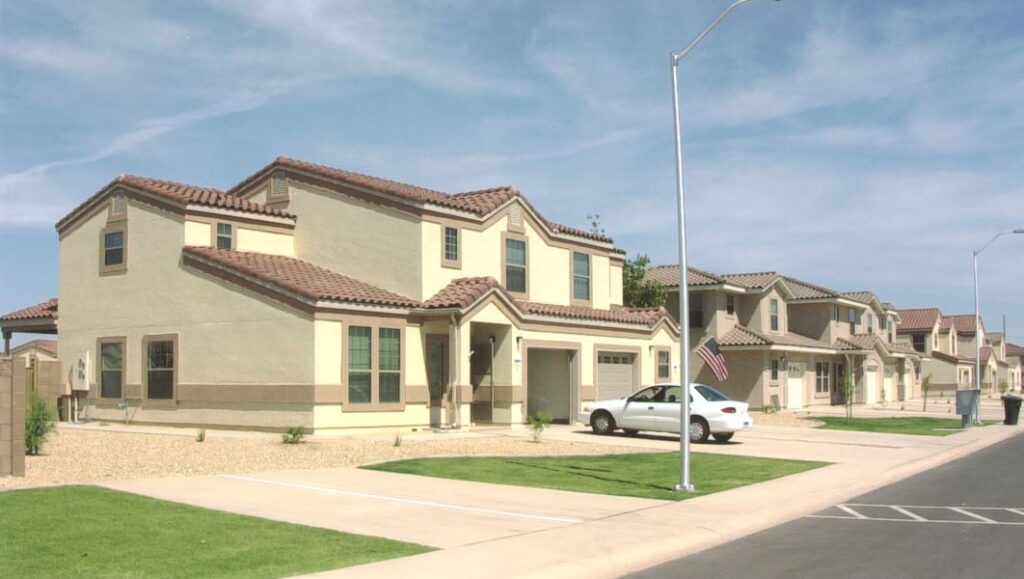
Commissary
During WWII, most of the people stationed at Luke Field were single and ate in the Chow Hall. Therefore, there was no need for a large Commissary. That was true at Luke Field. Pictured on the left is the staff and the small warehouse used as the Commissary. (Photo by Luke Field Photographic Section) Over time, the demographics of the base population changed to fewer single Airmen and more families. That put more demand on the Commissary. Until the new Commissary was built in 1974, pictured on the right, the base continued to use a small warehouse as its Commissary. (U.S. Air Force photo)
Gas Station
During WWII, most Airmen and students did not have cars at Luke Field. The base was designed so that everything was within walking distance for the students and single Airmen. For those who did have cars, a four-pump Gas Station was north of the North Gate and the second small building west of Litchfield Road, see photo on the left. (Photo by Luke Field Photographic Section) Today, the 56th Civil Engineer Squadron building stands in that location. In the early 1960s, they moved the Gas Station to a new location less than a block north of the WWII Headquarters building. In 2009, they build a new Gas Station with 16 pumps mixed with the Class 6 Store and some Exchange functions a couple of blocks east of the Hospital. It is called the Shoppette, see the photo on the right. (Photo by lukefieldaz.com)
1,000,000 Flying Hours
On February 7, 1944, just 32 months after the start of flying operations at Luke Field, the instructors and students flew their 1,000,000th hour, mostly in the North American Advanced Trainer (AT)-6 Texan. In the photo on the left, Col. John K. Nissley, the commander of Luke Field climbs off his AT-6 after flying the 1,000,000th flight hour for the field. There to congratulate him are (left to right) Col. Lester S. Harris, Director of Training, Maj. Hugh A. Griffith, Jr., Base Operations Officer, and Capt. William A. Payton, Assistant Operations Officer. (Photo by Luke Field Photographic Section) That was an amazing accomplishment, especially when compared to flight operations since then. At Luke Air Force Base, only one type of aircraft has flown 1,000,000 flight hours. That aircraft is the F-16 and it took the base 30 years of F-16 operations to attain that mark. On March 13, 2013, in the photo on the right, Lt. Wetherbee., a student in the 309th Fighter Squadron, flew a training mission that included the 1,000,000th flight hour for the F-16s at Luke Air Force Base. (U.S. Air Force photo)
Refueling Aircraft
One thing all powered military aircraft require is fuel. Delivering that fuel is often a hot, physically demanding job. While fuel types and delivery systems have changed over the decades, the job is still to safely deliver thousands of gallons of fuel to aircraft every day so they can fly. In the left photo, the refueling is done over the wing with something similar to a gas station hose and nozzle. (Photo by Luke Field Photographic Section) On the right, Airman 1st Class Katlynn Masnyk, 56th Logistics Readiness Squadron distribution fuels operator, pulls out a fuel hose from an R-11 Refueler to fuel an F-35A Lightning II on Aug. 21, 2019, at Luke Air Force Base, Arizona. R-11 Refuelers are used to refuel the jets and can carry approximately 6,000 gallons of fuel. Distribution fuels operators handle jet fuel, operate large vehicles and ensure the compliance of all safety regulations while performing their job. (U.S. Air Force photo by Airman Brooke Moeder)
Hangars
In aircraft operations, hangars and the space in them is very important. Airmen use the hangars for a number of functions. Most of those functions deal directly with the aircraft. The most important thing is that the hangars allow aircraft maintenance personnel to work on the aircraft out of the weather. While it definitely helps the people stay cooler, warmer, or drier, it is also important for the aircraft undergoing major maintenance. Hangars protect the aircraft from high winds, heavy rain, snow, and ice. Especially, while they are on jacks or their panels are off and the inner workings of the aircraft are exposed to the elements. During 1941, the Army built two sets of large twin hangars on Luke Field. The first set were gigantic Quonset Huts at the west end of F and G streets (now Eagle and Falcon Streets) that met at the east end at the main gate. One hangar of the second set is pictured on the left, while under construction. Located on the north end of the North Aircraft Parking Ramp, this hangar was for the 87th Sub Depot. (Photo by Luke Field Photographic Section) Taken from approximately the same location, the photo on the right shows the hangars have been replaced in that location by the North Aerospace Ground Equipment facility. (Photo by lukefieldaz.com) Pictured below is one of the new hangars built for the Lockheed F-35A Lightning II on the south side of the base. (U.S. Air Force photo)
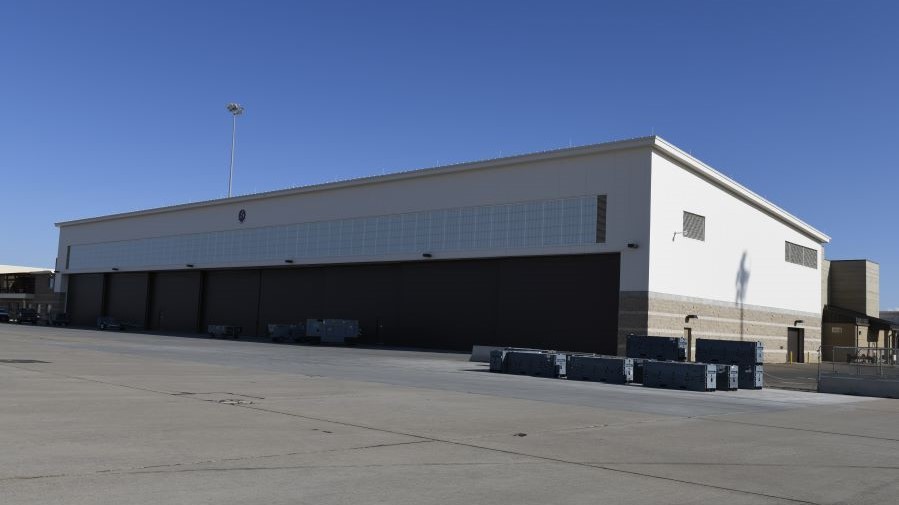
Canopy Repair
While materials and techniques have changed over time, repairing and upgrading canopies is still a very important job. While all pilots use canopies to see where they are going, fighter pilots use their canopies to search out enemy targets, even in peacetime training. On the left is a WWII picture of ladies repairing canopies in the Plexiglass Department of the 87th Sub Depot on the north end of Luke Field. (Photo by Luke Field Photographic Section) On the right, Senior Airman Matthew Romano (left) trained Airman First Class Delwyn Travillion (right), on July 13, 2020, to install flexible linear shaped charges on a canopy at Luke Air Force Base in buildings built south of the West Ramp. Both men were members of the 56th Component Maintenance Squadron. (U.S. Air Force photo)
Rigging Parachutes
In times of major in-flight emergencies, pilots rely on their parachutes to work flawlessly. Therefore, attention to detail is required when packing a parachute. On the left is the 87th Sub Depot Parachute Packing Section during WWII. (Photo by Luke Field Photographic Section) On the right, one can see that not much has changed as Staff Sgt. Kenny Batallas checks a parachute’s line continuity on June 20, 2019, at Luke Air Force Base, Arizona. Batallas is the noncommissioned officer in charge of the 56th Operations Support Squadron Aircrew Flight Equipment maintenance section. To ensure line continuity, Batallas checked that the parachute lines were not tangled or obstructed in any way. Twisted lines could pose a potential risk to the safety of the pilots. (U.S. Air Force photo by Airman 1st Class Leala Marquez)
Parachute Drying Tower
Prior to packing a parachute, sometimes they needed to be washed and then dried. To dry them, they are hung inside a tower to help them dry. On the left is the 87th Sub Depot’s Parachute Department and WWII drying tower. (Photo by Luke Field Photographic Section) On the right is the 56th Operations Support Squadron Aircrew Flight Equipment facility and its current drying tower. (Photo by lukefieldaz.com)

